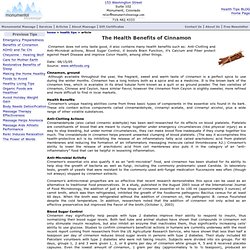

The Health Benefits of Cinnamon. Home > health tips > article The Health Benefits of Cinnamon Cinnamon does not only taste good, it also contains many health benefits such as: Anti-Clotting and Anti-Microbial actions, Blood Sugar Control, it boosts Brain Function, it's Calcium and Fiber protect against Heart Disease and improve Colon Health, among other things.

Date: 08/15/05 Source: www.whfoods.org Cinnamon, ground Although available throughout the year, the fragrant, sweet and warm taste of cinnamon is a perfect spice to use during the winter months. Cinnamon has a long history both as a spice and as a medicine. Health Benefits Cinnamon’s unique healing abilities come from three basic types of components in the essential oils found in its bark. Anti-Clotting Actions Cinnamaldehyde (also called cinnamic aldehyde) has been well-researched for its effects on blood platelets. History Cinnamon is one of the oldest spices known.
For References and more information, visit: www.whfoods.org. Cinnamon. Cinnamon sticks Cinnamon (/ˈsɪnəmən/ SIN-ə-mən) is a spice obtained from the inner bark of several trees from the genus Cinnamomum that is used in both sweet and savoury foods.

While Cinnamomum verum is sometimes considered to be "true cinnamon", most cinnamon in international commerce is derived from related species, which are also referred to as "cassia" to distinguish them from "true cinnamon".[1][2] Cinnamon is the name for perhaps a dozen species of trees and the commercial spice products that some of them produce. All are members of the genus Cinnamomum in the family Lauraceae. Only a few of them are grown commercially for spice. Etymology[edit] The name "cinnamon" comes through the Greek kinnámōmon, possibly from Phoenician.[3] In Hindi it is called dal chini. In Sri Lanka, in Sinhala, cinnamon is known as kurundu (කුරුඳු),[4] and was recorded in English in the 17th century as "korunda". History[edit] Cinnamomum verum, from Koehler's Medicinal-Plants (1887) Cultivation[edit]
Cinnamon Health Benefits – A Natural Remedy. Cinnamon Health Benefits Come from Antioxidants. You may love the warm, distinctive flavor that cinnamon adds to food dishes.

But did you know that this ancient spice, taken from the bark of tropical trees, has one of the highest antioxidant levels of any spice? Antioxidants are responsible for many cinnamon health benefits. Cinnamon has more antioxidants than many so-called antioxidant foods, ounce-for-ounce. One teaspoon of cinnamon has as much antioxidant capacity as a full cup of pomegranate juice or a half-cup of blueberries. Beyond antioxidants, cinnamon is also rich in natural compounds called polyphenols. Nutritional Content of Cinnamon. Cinnamon health benefits come from three basic types of components in the essential oils found in its bark. The parts of this plant that are used medicinally are the dried inner bark of the shoots and the oil distilled from the bark and leaves. A USDA study found that cinnamon health benefits lasted for at least 20 days after people stopped taking it.
10 Health Benefits of Cinnamon. Cinnamon Health Benefits. Cinnamon is a sweet, aromatic spice and a medicine.

It is one of the oldest spices known to man. Its uses and benefits have been documented as early as 2700 B.C. throughout China, Europe and Egypt. There are two types of cinnamon, Ceylon and Chinese (cassia). Cinnamon offers anti-clotting and anti-microbial benefits, boosts brain function and contributes to a healthy colon. It may also help control blood sugar in people with diabetes.
Three components found in the essential oils of cinnamon bark that offer health benefits include cinnamaldehyde, cinnamyl acetate and cinnamyl alcohol. The benefits of cinnamon on blood-sugar control have been well documented. Cinnamon may work in another way to help lower glucose levels. Some research suggests that the aroma and flavor of cinnamon acts as a cognitive stimulant, possibly improving working memory, visual-motor speed and virtual recognition memory.